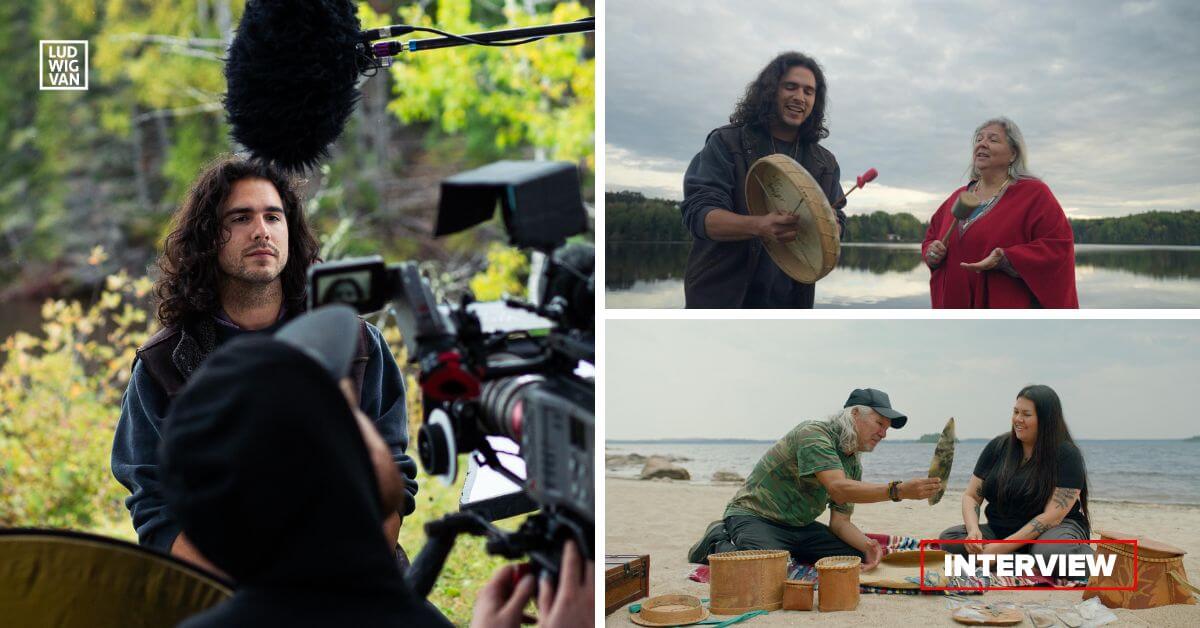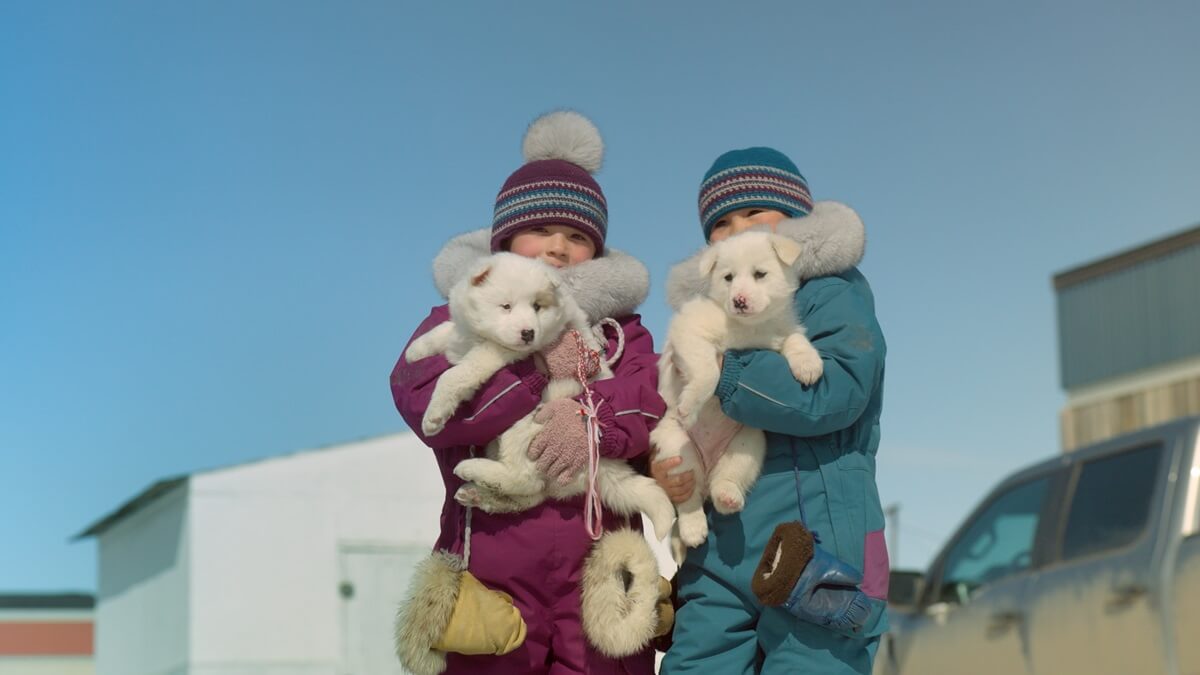
Wolastoqiyik composer Jeremy Dutcher is just back in Canada from Germany. He was in Leipzig, where he visited Bach’s church and Mahler’s house. “It was really special to be in the cradle of the style of music that I’ve studied my whole life,” he says. “There’s so much beauty there, in that order.”
He’s in Toronto to promote a handful of projects. His second release, including his first single in English, is titled Motewolonuwok, and set to drop on October 6 on Secret City Records.
He’s also come to town to talk about his involvement in Telling Our Story, a four-part documentary that’s premiering at TIFF23.
The Series
The series by Terre Innue showcases the stories and culture of the 11 First Peoples in Quebec, Canada — Abenaki, Anishnabe, Atikamekw, Cree of Eeyou Istchee, Innu, Inuit, Mi’gmaq, Kanyen’kehà:ka (Mohawk), Naskapi, Wendat, and Wolastoqiyik (Maliseet).
Award-winning Abenaki director Kim O’Bomsawin (Call Me Human, Quiet Killing) and a primarily Indigenous production team travelled to 30 communities across tens of thousands of miles to compile the segments. The voices and stories are woven together into a narrative that conveys their ways of life. The result is infused with music and aims to inform as it entertains and showcases the depth and diversity of Indigenous cultures.
Each of the four episodes revolves around a theme: Territory, Identity, Spirituality, and Rebuilding.
You can catch the first two episodes during TIFF23 on September 15 and 16. Tickets here.
The series will air on CBC Gem this fall.
The Interview
“It’s really special, that documentary series. Kim is awesome.” Dutcher became involved by reputation. “I think they had known my work through my work and my first album. Which, you know, had a little bit of success. It won a JUNO Award,” he says. He explains that the recognition came as a surprise.
“It was just like a little project I created for my community,” he explains. The album’s songs are sung in his native language. “Our language is endangered,” he says. “It was very important to me.”
In Telling Our Story, others talk about the impact it had on them emotionally to hear Wolastoqey sung and heard by so many people. Blending Western and Indigenous idioms in music is part of Jeremy’s cultural background.
“I was studying opera at school, at university, singing all these old songs from dead Europeans, which is great — there is so much beauty there — but there’s nothing in the canon that felt like it really spoke well to us as Indigenous people.”
He thought Indigenous melodies were just as beautiful, and the language itself has its own kind of poetic vision. “I wanted to highlight that. That’s kind of what the series is about, too.”
The alignment of themes made him the perfect subject for the series. He appears in the first two episodes of Telling Our Story. “The Wolastoqiyik nation, where I come from, is one of the 11 nations of Quebec, which is the framing of the series.”
The boundaries of the nations in question spill over into Ontario and the Maritimes, however. Jeremy Dutcher is a Wolastoqiyik (Maliseet) member of the Tobique First Nation in New Brunswick. His local Indigenous language is Wolastoqey/Maliseet.

“They asked me to represent our nation and tell my story through that land,” he says. “I invited them to the reserve where my mom is from. We chatted right on the water about the influence of language.” There are ongoing efforts to preserve it. Wolastoqey/Maliseet is in real danger of dying out. “There’s less than 100 fluent speakers left.”
Language is crucial to cultural identity, in that it is the basis for expressing a way of life. Telling Our Story also underscores the importance of language in the second episode, titled Identity. Through translating simple terms, viewers begin to understand the perspective and worldview of the different Indigenous speakers.
It speaks of a way of life that’s inseparable from the land — a way of life that seems diametrically opposed to contemporary Western-style capitalism and its digital nomads, its endless appetite for travel…or is it really? There’s the Indigenous creation legend about two fish who eventually leave the water for land, grow legs, and begin to walk upright.
“There’s something maybe untranslatable or unspeakable between us that is beautiful and hard to express in any given language,” he says of the colonizer/Indigenous cultural divide. Growing up in a bicultural household, it’s something he learned to put into context from day one.
“We just had to figure it out,” he says. Balancing and sharing both was the only option. “I think that’s kind of what Canada has kind of been putting our head in the sand and not doing for about 500 years — is not figuring it out.”
It was through the love of his parents, and the reverence he had for both cultures, that he grew up with the feeling that coming together was somehow possible. That came despite the fact that, as he points out, he also grew up during the time of the Oka Crisis.
“They were burning effigies of native people in the streets,” he recalls. There is a simmering current of anti-Indigenous sentiment that too often rears its ugly head in Canadian society.
“How do we meet that with grace?” he wonders. “I’ve been thinking about that my whole life. We’ve all been miseducated,” he adds. “How do we meet that […] ignorance […] not really seeing each other as people, how do we meet that with love, and try to interrupt that? The headlines tell one thing. On the ground is a whole other thing. Between there is a possibility of getting together.”
Art, music and culture in general are the best way of reaching out, and that’s what Telling Our Story focuses on. Each episode weaves together the voices, stories, and cultural expression of multiple nations into a kind of stream that offers viewers a glimpse into their lives and homes. That approach also reflects the Indigenous way of life, where the 11 nations shared land and resources without the concept of land ownership.
Jeremy Dutcher – The Music
The series gave him the opportunity not only to talk about his home and culture, but to perform.
“I have such reverence for the form of film making,” he says. Some of his tracks have been used in various film and TV projects. In the series, he plays a grand piano that was brought to the reserve in the woods.
“It was really special to record that,” he says. “You can hear the leaves falling.” Jeremy often performs and records with the voices of his ancestors, as captured on vintage vinyl records.
“That’s my form of resistance, my form of activism I guess, is through song and through language.”
It meshes with the series’ mandate of showcasing the beauty of Indigenous cultures, and building them up. His compositions synthesize Western classical and Wolastoqiyik elements. Harmonically and melodically, it sounds somewhat familiar to those trained in the Western traditions, but also different, drawing on the rhythms of his language, and traditional melodies. The result is a compelling conversation between worlds.
“That’s just what it is — a conversation. A dialogue,” he says. “As someone who’s trained in that Western art music tradition, there’s beauty there as well, and you’ve got to weave it together. That’s where the conversation lies, in the middle ground.”
As he points out, there were many composers in the American tradition who’ve used Indigenous melodies and other elements in their own music, but it never felt like an authentic representation of Indigenous identity. It’s the first time in history that the conversation has been one of equals.
It’s also about looking at the notion of what “classical” means when it comes to music. Certainly, there is a vast body of Indian classical music, and Chinese, South American, African.
“What does Indigenous classical music sound like? I don’t feel like we’ve had that. So, it’s like, if you don’t see it in the world, then just make it,” he explains. “For me, that was the philosophy of why I wanted to do it.”
He says he was inspired by the words of Buffy Sainte-Marie, who famously said, “Some will tell you what you really want ain’t on the menu. Don’t believe them. Cook it up yourself and then prepare to serve them.”
As he puts it, “You go and create, and then you offer.”
With such diverging values, can Indigenous ways of life and European style capitalism ever live together peacefully?
“I would interrupt the question and say, is this what we live in?” he begins. Certainly, we’ve inherited a way of life in North America, but it’s one that is in a current state of flux. “There’s other ways of existing. And those ways of existing have been around a lot, lot longer.”
The series comes at a unique time.
“In my understanding, Canada doesn’t even know us,” he says. However, we’re in a moment right now where sharing from an Indigenous perspective is finally possible. “There’s an equity to the conversation that hasn’t been there before.”
“We do ourselves, as humanity, a disservice when we’re not listening to everyone, and not everybody, and every perspective, is at the table.”
#LUDWIGVAN
Get the daily arts news straight to your inbox.
Sign up for the Ludwig van Daily — classical music and opera in five minutes or less HERE.
- PREVIEW | SUMMER OPERA LYRIC THEATRE Presents Handel’s Xerxes, Mozart’s Idomeneo & Puccini’a La Boheme July 26 To August 4 - July 26, 2024
- PREVIEW | YENSA Festival V.2 Offers Black Flames Performances & Other Ways To Celebrate Black Women In Dance - July 25, 2024
- PREVIEW | Canadian Talent Conspicuous In The Met: Live In HD 2024-25 Season - July 25, 2024



